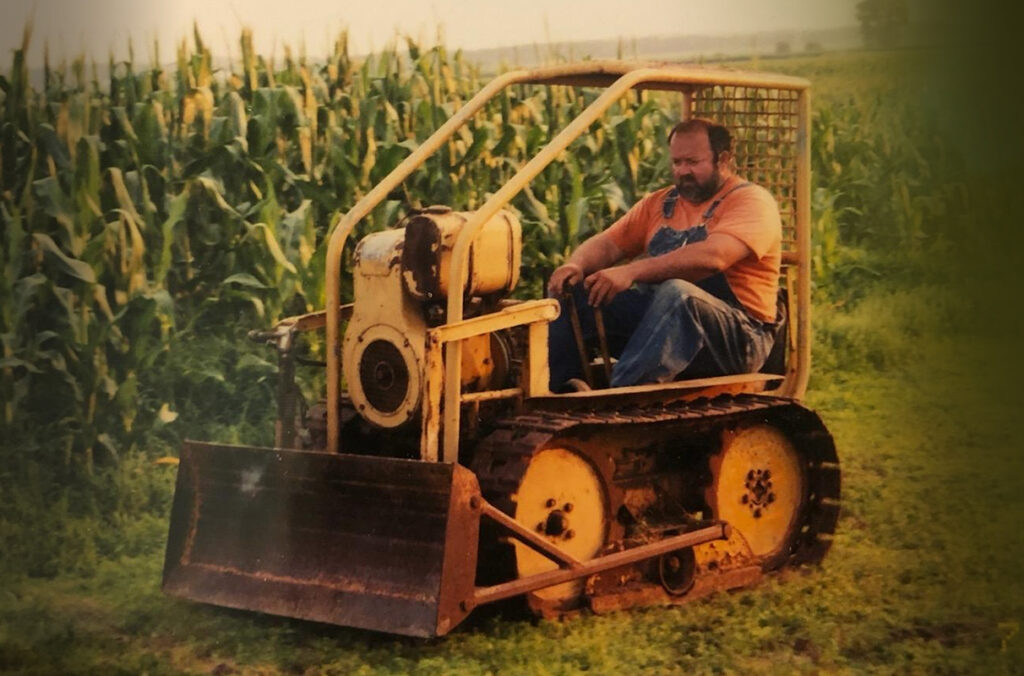Cougs always find their way home. Their bulldozer did too.
Students in Washington State University’s Agricultural Technology and Production Management Program (AgTM) will overhaul and bring back to life a one-ton, custom-made miniature bulldozer believed to have been built by their student forerunners in the 1960s.
The antique machine was donated this fall by an Illinois family after a long career of Midwestern farm work, as well as stints digging basements under houses.
“To most people, it would have looked like an interesting piece of junk,” said Tom Steffen, who donated the heavy piece of equipment with his teenage son, Brock, after connecting with lead instructor Tadd Wheeler and program supporter Mike Scannell. “These guys realized the importance.”
There are no markings on the dozer, and no records left behind from construction have been found, but owners have passed down a steady, repeated story that the machine was built by students at the Pullman campus. Specific parts date from the late 1950s. Under five feet long, with a blade less than four feet wide, it’s tiny compared to standard-sized machines.
“It’s probably one of a kind,” Wheeler said.
Built as a teaching tool, the dozer helped its creators learn the fundamentals of hydraulics and mechanics. Once built, it was likely sold, and wound up in the Midwest.
Mighty, pint-sized pusher
Brock’s grandfather, Mark Broline of Port Byron, Illinois, purchased the dozer about 30 years ago from a prior owner in Rapid City, Illinois. Broline used it to move earth on his farm. Before that, the tiny dozer was used in construction and proved handy digging basements under existing houses. Now equipped with a sturdy roll cage, it could slip under houses and push dirt out the other side.

Family members who drove it “were astounded at the amount of work it could do,” Steffen said. “It’s an excellent design. And very durable.”
Cobbled together from myriad sources, the dozer is a masterpiece of improvisation. Its caterpillar tracks were made from durable railroad spike plates. Started by handcrank, its 9-horsepower, single-cylinder engine generates massive torque by way of an oversized flywheel. The driver steers by slowing one set of tracks.
Never overhauled to Steffen’s knowledge, it hasn’t run for a decade. Broline gifted the dozer to Brock, and Steffen hung onto it, thinking his son would one day drive it as part of the family demolition and excavation business. By the time he was grown up enough to do that, Steffen realized Brock could handle a full-size machine. He decided to see if he could arrange a homecoming instead.
“I wanted that little machine to go back, so people can see technology that has advanced since the program’s early days,” he added. “Maybe alumni who worked on it could meet with students and learn about their projects today. WSU alumni take a lot of pride in that school.”
Understanding the test of time
Steffen linked up with AgTM by way of a friend in Illinois, Ed Simpson, who knew Mike Scannell, a Pierce County resident and WSU supporter. Scannell donated funds toward the dozer’s return and repair, hoping others would join in. The 1,700-mile ride to Washington was provided by Pullman-based contractor Fred Wexler, who had driven to the Midwest to pick up equipment.
The dozer is an ideal club and classroom project for students in AgTM, who learn about science and technology and master many mechanical disciplines.

“A big part of what we emphasize is management—making your equipment last,” said Wheeler, who was thrilled to have it back in his program’s classroom-garage-workshop at Pullman’s L.J. Smith Hall, home to agricultural mechanics at WSU since 1947.
“Seeing what the test of time has done helps our students manage real operations,” he said. “It’s been sitting for a while outside, but machines do that. We should be able to refurbish everything.”
Wheeler encourages any program alumni to reconnect with AgTM and share their memories about the construction and origins of the bulldozer.
Once overhauled, painted crimson and gray, the dozer may become a feature of campus events and fairs.
“There’s nothing like this,” Scannell said. “Students designed, researched, and came up with all these different parts and put them together to create this mini-dozer. It was quite a feat. It’s unique to WSU.”






